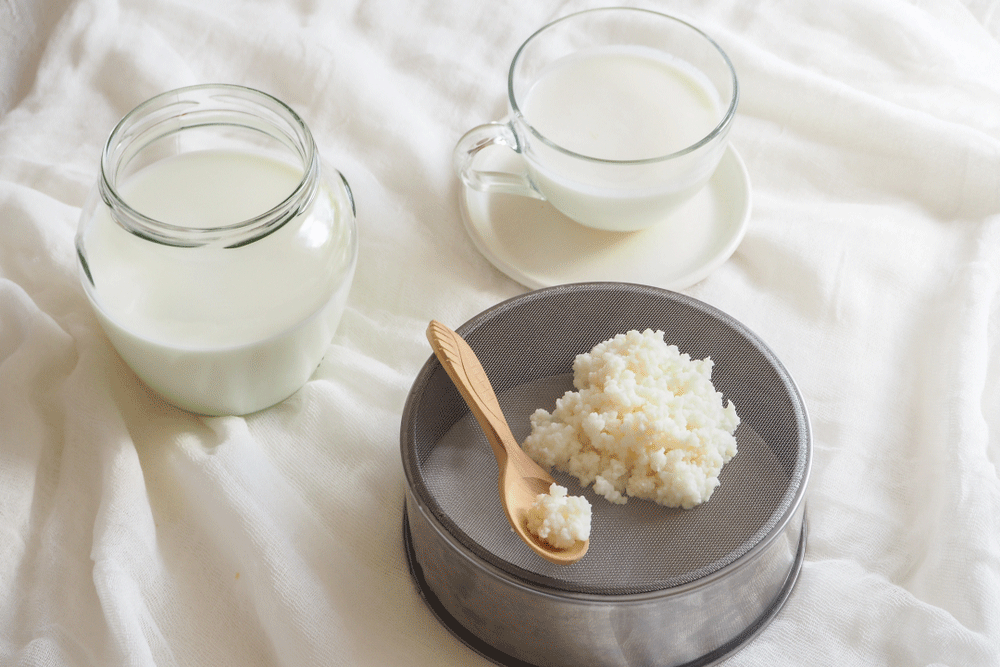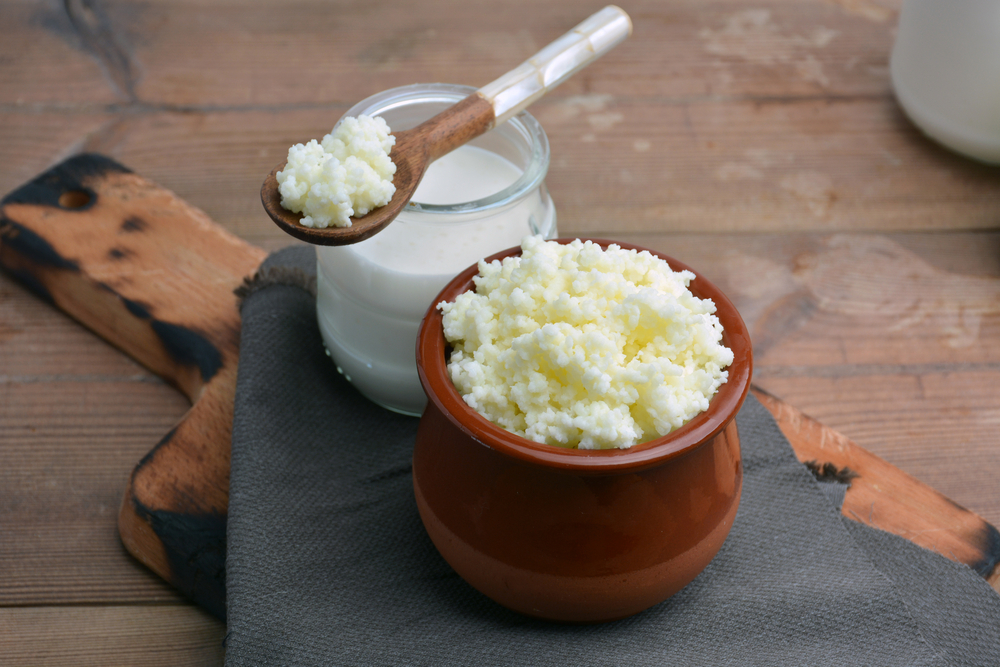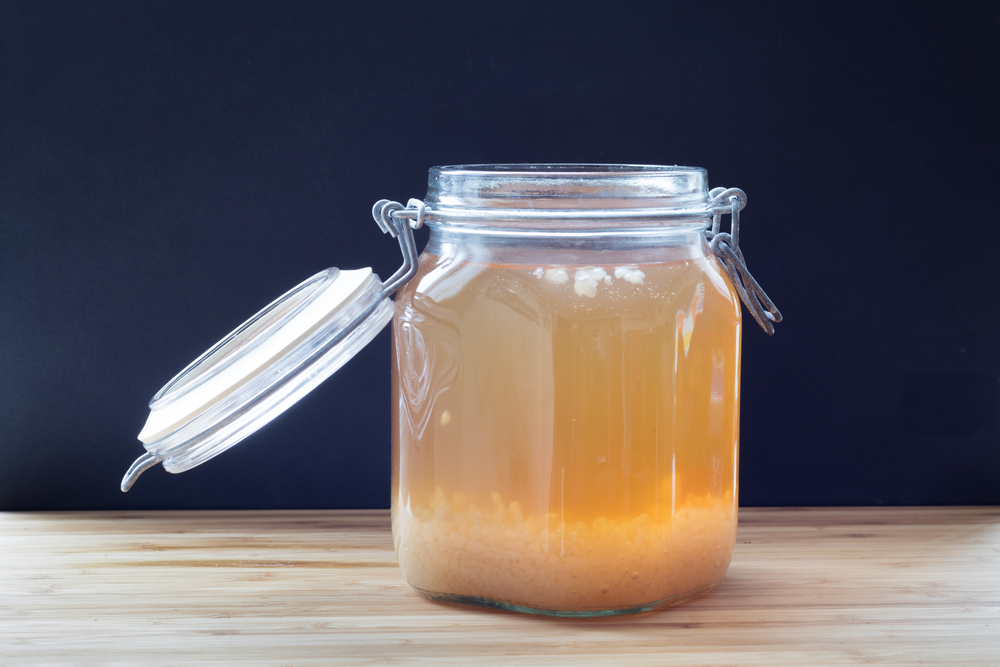
08 Apr Make Your Own Kefir – The Probiotic Drink Your Gut Will Love
What is Kefir?
They say the word kefir originated from the Turkish word “Keif” which means “good feeling”. That’s your first clue that you may just end up loving it. It’s said to have originated in the Caucus mountains, where shepherds would keep their milk in leather pouches and it would ferment into fizzy, cultured milk. What causes this fizzy fermentation (and delicious tart, sour taste) is the secret.
Kefir grains are a symbiosis of over 30 different microflora clumped together into little colonies called a SCOBY, that looks like cauliflower florets, making it more of a plant than “grains”.
Now about that feel-good feeling – it is becoming increasingly accepted that your gut plays as big a role in your mental health and moods as your brain does. All the little organisms forming a community in your gut – the good ones that you want there that is – they help your body process hormones, and it’s even been discovered that 90% of your body’s serotonin is made in the gut and depends on the help of these little creatures!
That’s where kefir comes in – it’s a probiotic par excellence that’s even a notch above yoghurt when it comes to creating healthy gut culture. Whereas yoghurt cultures act as food for the microflora in your gut as they pass through, kefir cultures actually colonise your gut with the healthy microflora you need. This includes yeast that combats unfriendly salmonella and E. Coli, as well as that famous nasty, candida.
TWO KINDS OF KEFIR
This sometimes causes some confusion – there are two kinds of kefir – water kefir and milk kefir. Some people think that they are interchangeable, but in fact they are not, they are two distinct and separately developed cultures.
MILK KEFIR: If you want to make milk kefir, which feeds on the milk sugar lactose, you need to get milk kefir grains, a cauliflower-like opaque culture. Although fermenting milk with kefir makes it much more digestible for those who are lactose intolerant, if you are vegan, or are really sensitive to milk, you can try water kefir instead. You can culture non-dairy milks with milk kefir SCOBY, but the results may be iffy. If you do do it, you will need to immerse your SCOBY in dairy milk every few batches to refresh it with some lactose. It has a delicious, tart yoghurt-like taste.
WATER KEFIR: has a string of interesting names – bees, Japanese Water Crystals, Graines Vivantes, Balm of Gilead – and has a transparent appearance. It feeds on cane sugar, fruit juice and coconut water. it needs sugars to survive. Its origins are hazy but it is thought to have originated in Mexico. It has a pleasant tart, fermented taste with a subtle fizz.
KEFIR’S HEALTH & HEALING EFFECTS:
- Colonises your gut with healthy strains of beneficial microflora
- Promotes a wide variety of microflora that is believed to be even more potent than those found in yoghurt (yoghurt bacteria feed beneficial bacteria as they pass through, kefir actually provides the beneficial bacteria that stays in your gut)
- Contains beneficial yeasts that are known to destroy pathogenic yeasts such as candida
- It contains bacteria that yoghurt doesn’t, that actually penetrate the gut lining to cleanse, purify and strengthen the intestinal walls and help your body become more resistant to dangerous pathogens such as E. Coli, salmonella, candida overgrowth, and intestinal parasites
- Improves various digestive diseases, promoting healthy bowel movement and easing diarrhoea
- The bacteria in kefir are powerful detoxifiers
- Helps assimilate nutrients in the gut and enhances the use of certain trace minerals and B vitamins
- It has a soothing, relaxing effect on the nervous system which can help those with insomnia, anxiety and depression
- By restoring the gut balance, kefir can help issues such as blood sugar imbalances, sugar cravings, weight gain, poor immunity, low energy and digestive disturbances
- It has been found to have anti-cancer properties
- Antibiotics literally mean “anti life” and that’s what they can do to your gut, kill the healthy microorganisms that are so important to your health. Kefir can help recolonise your gut with the good flora you need if you have been on antibiotics.
In the specific case of milk kefir…
- Helps your body assimilate calcium found in milk. Full cream milk is the best milk to use as it also contains vitamin K2 which keeps your bones strong and arteries clear
- The lactic acid bacteria in kefir predigest lactose making it easier to tolerate for those with lactose intolerance
- It makes the nutrients in milk more available and easily digestible (kefir should not be heated before you take it, it would destroy the healthy enzymes)
In a nutshell (or a SCOBY), a healthy gut makes for a healthy immune system, fortifying you against all manner of diseases.
You can make kefir regular part of your routine and reap the benefits. Even just a tablespoon or two a day makes a great probiotic supplement. You can also pep it up with flavours or add it to your smoothies.
HOW DO I MAKE MY OWN KEFIR?
For a start, you will need to get hold of the correct kefir grains – water or milk. You can either buy them, or some people are happy to share some of their kefir culture with each other, if you know someone who’s a kefir enthusiast.
The beauty of culturing your own kefir is that once you get going, you can have kefir for life – the culture keeps growing. It’s like having a new pet that makes you lots of healthy probiotics for as long as you feed it and look after it properly. So treat your SCOBY well!
Once you have the grains, you’re ready to go. If you have bought dehydrated grains, you will first need to prepare them by letting them feed on a few batches of milk or sugar water to get strong again. If you get them live from a friend or buy them hydrated, you can pop them in and they’ll get down to business immediately.
Dehydrated grains can be stored for a while in the fridge until you are ready to use them, but hydrated ones should be used as soon as possible.
Now we’ll look at how you can make your own Kefir using either milk or water Kefir culture.
1. MILK KEFIR
SOME POINTERS…
- Your kefir is alive and will keep growing bigger, you’ll need to subdivide it when it reaches the size of a pecan nut. If it grows too big your kefir will start tasting very tart and stringent
- The rate of fermentation depends on the ratio of the amount of grains you use to the amount of milk – the more grains you use, the faster your kefir will culture
- A pea-sized kefir grain will culture1 litre milk in about 48 hours if kept at 25°C
- The colder the temperature especially in winter, the longer it will take to culture
- If you want to culture more milk then it will take longer
- Try not to handle the grains with your hands
- Use non- reactive utensils such as sterilised plastic, wood or stainless steel – if possible avoid metals altogether as the acids in the ferment can leach toxins from the metal
- Avoid aluminium utensils
YOU WILL NEED:
- Your Milk Kefir SCOBY
- A glass jar to contain the milk you want to ferment. Bear in mind that your culture needs to breathe. You can either use a jar with an airlock, or you can do the simple version of covering it with a paper towel or muslin cloth and securing it with a rubber band
INSTRUCTIONS:
- Transfer your kefir grains into a glass jar/fermentation vessel and add 1 cup of fresh milk
- Cover the top of the glass jar and either apply the airlock cover with the muslin cloth or paper towel secured by a rubber band
- Place in a warm spot, 20°C – 30°C, to culture
- Culture until milk is slightly thickened and aroma is pleasant – Generally 24 – 48 hours
- After culturing is complete, separate the kefir grains from the finished kefir
- Place the kefir grains in a new batch of milk
- Store the finished kefir in the refrigerator
- Finished kefir will remain palatable if kept in the fridge for up to 10 days.
ADDITIONAL TIPS…
- For best results use fresh full cream organic or pasteurised goat’s or cow’s milk
- Low-fat milk may also be used
- Avoid using ultra pasteurised or UHT milk
- Rice, soya or coconut milk may also be used but alternate every second batch with goat’s or cow’s milk otherwise your kefir will die as kefir feeds on the lactose in milk
- If you want to take a break from making kefir you can pour fresh milk onto the kefir grain/s and put it in the refrigerator for no longer than 3 weeks
- If you intend to stop making kefir for longer than 3 weeks, ask somebody to tend your kefir grain/s
- Fermented foods have a sour but clean aroma and flavour. Never consume anything that smells or tastes unpleasant
2. WATER KEFIR
As we said, water kefir can be made with sugar water, coconut water or fruit juice.
As with the milk kefir, if you have dehydrated grains, you will need to re-hydrate them in a few times to get them up and running.
Note: you can’t transfer water kefir grains to ferment dairy milk as they are not the same type of cultures. The finished kefir (not the culture itself, the cultured water) can be used to culture simply delicious nut cheeses, as well as make non-dairy kefir (as you don’t use the grains, each batch would be a once off)
Diabetics: as most of the sugars in the liquid are used up by the bacteria, some diabetics can tolerate water Kefir, but it would be better to use less sugary bases such as coconut water rather than pure fruit juice which has much higher sugar content
SOME POINTERS…
- Use unchlorinated, unfluoridated water
- Use white sugar, raw cane sugar (whole cane sugars such as Rapadura or Sucanat), organic cane juice crystals or Turbinado
- Coconut sugar may be used, though it can be hard on the water kefir grains. It’s best to use it in combination with cane sugar
- Don’t use honey, agave, stevia or other sugar substitutes
- Avoid metal utensils when making water kefir. Rather use non-metallic utensils such as plastic or wood, as the metal can react with the acids in the kefir
- Avoid handling the grains with your hands
YOU WILL NEED:
- Your Water Kefir grains
- A glass jar to contain the liquid you want to ferment. Bear in mind that your culture needs to breathe. You can either use a jar with an airlock, or you can do the simple version of covering it with a paper towel or muslin cloth and securing it with a rubber band
- Sugar
- Coconut water or fruit juice if you are doing one of those options
INSTRUCTIONS:
- Sterilise your glass jar/fermentation vessel by putting it in hot boiling water for 3 minutes then throwing the water out
- Heat 3-4 cups water. To make larger batches, use up to 8 cups water
- Pour into glass jar/fermentation vessel
- Dissolve ¼ cup sugar per litre of water
- Cool to 20°C – 25°C (room temperature)
- Add water kefir grains.
- Cover the top of the glass jar/fermentation vessel with either an airlock (preferred) top or with a coffee filter or cheesecloth or paper towel secured by a rubber band
- Place in a warm spot, 20°C – 30°C, to culture, for 24 to 48 hours
- After culturing is complete, prepare a new batch of sugar water as you did for the previous batch
- Separate the kefir grains from the finished kefir water and place water kefir grains in the new batch of sugar water you have just prepared
The finished water kefir is now ready to do one of the following with:
- Consume immediately just as it is
- Add flavourings to it and consume immediately
- Refrigerate and consume when cold
- Add flavourings, refrigerate then consume when cold
- Do a second fermentation
SECOND FERMENTATION
A second fermentation is when you leave your already cultured kefir (with the grains removed) outside the fridge a bit longer. The result is delightfully zippy and fizzy.
- Put the cultured kefir in an enclosed bottle and leave out the fridge for another day or two to carbonate. This puts more “fizz” into your kefir drink
- You can also add flavours then put in an enclosed bottle, and leave it out the fridge for another day or two to carbonate and then refrigerate
Flavouring ideas: Ginger and dried cranberries or Lemon juice or Vanilla
Tip: The actual water kefir (the liquid, not the grains) may be used to culture non-dairy milks for a non-dairy milk kefir alternative, as well as culture delicious nut cheeses!
You will need to first get your kefir grains nice and strong by feeding them in a few batches of sugar water first if they are dehydrated when you receive them, before you can make coconut water kefir, as coconut water doesn’t have a lot of sugars in it. Once your grains are well fed with sugar water and going strong, you can make a batch of coconut water kefir. Alternate every couple of batches of coconut water kefir with a sugar water version to keep them viable.
Signs You Need To Heal Your Gut (They’re Not What You Think)





Shirley Jooste
Posted at 09:03h, 14 AprilBrilliant, tasty ideas!
Nicole Puchner Bernic
Posted at 09:48h, 21 AugustI got some kefir from a friend about 3 years ago. I stopped making the kefir but kept them in the fridge for about a year. Coudl I still use it or must I throw it out? if so where can I get some from?